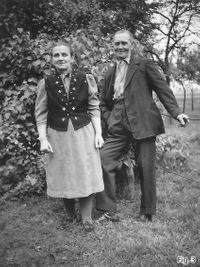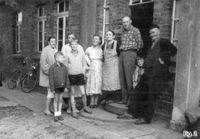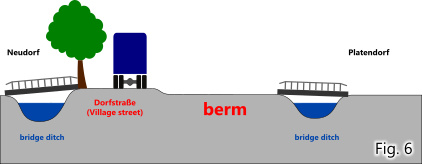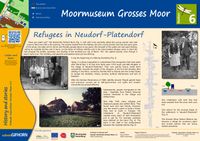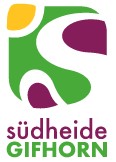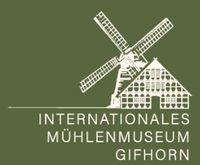Refugees in Neudorf-Platendorf
“Have you eaten yet?” blacksmith Richard Bock (Fig. 3 with his wife Lina) asked the young woman who fetched milk from him in the evening. The woman looked from the hall into the eat-in kitchen. She saw the warm glow of the lampshade, the laid table and friendly people before grace. She thought of the week-long flight, the food in the ditch, in barns, on the back of military vehicles and in the overcrowded refugee accommodation. In April she had escaped bombed-out Berlin, bullets, grenades and a hail of bombs. "No," she said quickly, although it wasn't quite right. The normality, the peaceful atmosphere, was too tempting. It was the beginning of a lifelong friendship (Fig. 2).
Immigration after the Second World War is hard to comprehend today. At that time, 1,074 locals and 686 refugees and displaced persons lived in Neudorf-Platendorf. Because of their own painful history, there was understanding for the need. In the first decades after settling in the moor, many families fled to Poland and the USA to escape want, misery, poverty, the unfree and arbitrary political conditions.
Stabilization followed the German Revolution in 1848. People gained hope and economic success was evident. Self-government, civil rights and a modern commercial law had an effect. As a result, there was immigration, especially from Poland. Seasonal workers stayed in the village and became at home. Many refugees and expellees also settled down after 1945. They found work and friends. Only a few, however, a building site. They had to build in triangle. The people of Neudorf-Platendorf needed every piece of land to make ends meet.
For example, potatoes were planted on the berm (Fig. 4).
The berm is the step in the embankment of the road embankment to the Platendorf bridge moat (Fig. 6). Land so hard wrested from the moors was sold by few owners.
One reason for the unusual form of settlement in Neudorf-Platendorf (Fig. 5). The Großes Moor nature reserve is now a refuge for many plants and animals that are displaced elsewhere.
Links to other stations in the museum - in English language:
<1> <2> <3> <4> <5> <6> <7> <8> <9> <10> <11> <12> <13> <14> <15> <16> <17> <18> <19> <20> <21> <22> <23>
